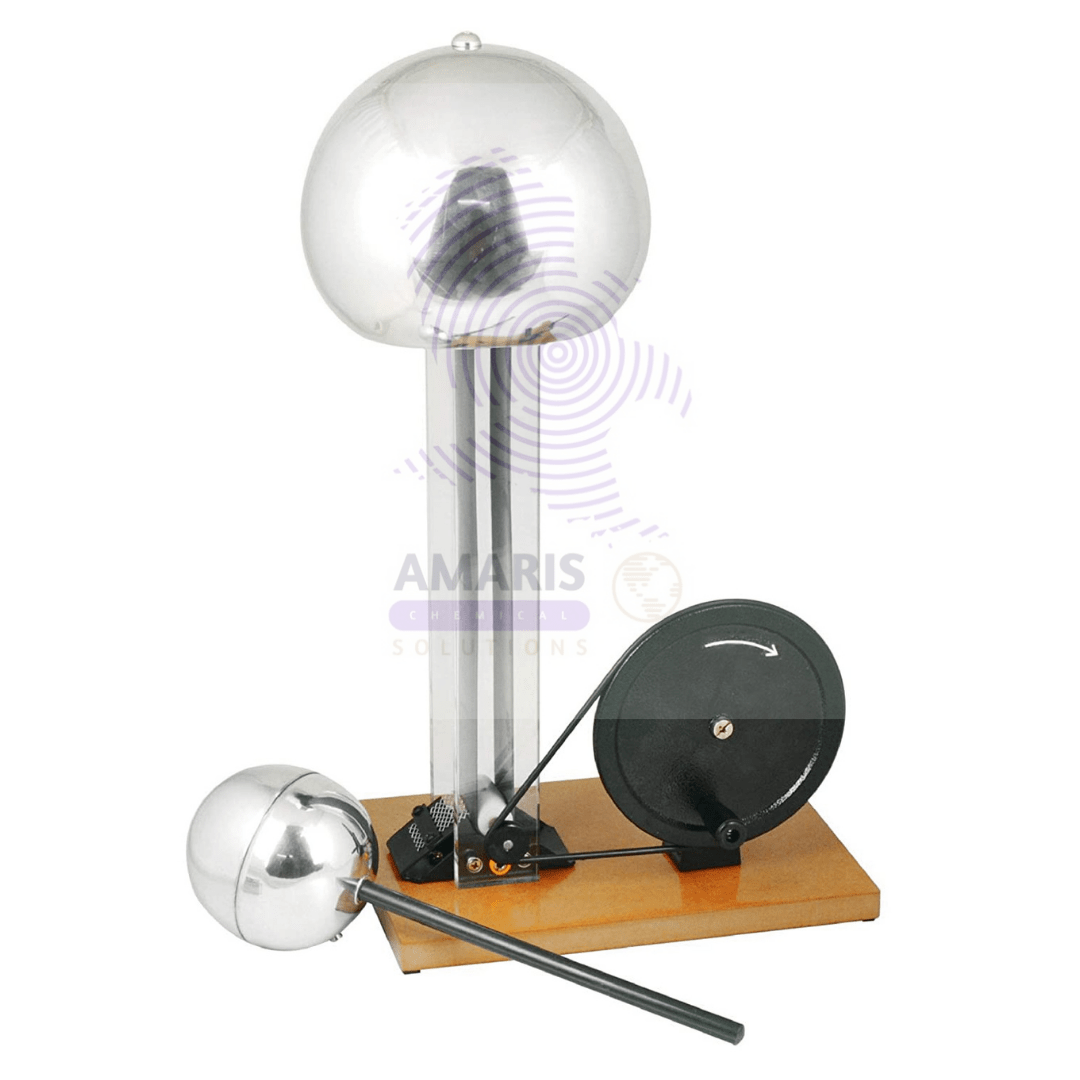“Barometer tubes” has been added to your cart. View cart

Burette acrylic
$0.01

Ticker tape timer
$6,000.00 Original price was: $6,000.00.$5,500.00Current price is: $5,500.00.
Van de generator manual
$7,000.00 Original price was: $7,000.00.$6,000.00Current price is: $6,000.00.
Whatsapp Order
Van de Graaff generators are commonly used in laboratory settings to demonstrate principles of electrostatics and high voltage phenomena. While specific manuals can vary based on the manufacturer and model of the generator
SKU:
ACS37973CHEM0
Category: LABORATORY EQUIPMENT & APPARATUS
Description
Van de generator manual
- Setup:
- Place the Van de Graaff generator on a stable, level surface, preferably grounded to prevent electrical interference.
- Ensure the generator is connected to a suitable power source, adhering to the specified voltage and current requirements.
- Confirm that all necessary safety precautions are in place, including the use of personal protective equipment (PPE) such as safety goggles and gloves.
- Assembly:
- Erect the generator components as per the provided instructions, including the base, insulating column, belt assembly, and terminal sphere.
- Securely attach any supplementary apparatus, like discharge wands or Faraday cages, following the manufacturer’s guidelines.
- Charging:
- Activate the Van de Graaff generator by toggling the power switch to the “On” position.
- Gradually adjust the voltage settings, starting from the lowest setting and incrementally increasing to the desired level.
- Allow sufficient time for the generator to build up charge accumulation on the terminal sphere or dome.
- Experimental Procedures:
- Conduct a range of experiments to elucidate electrostatic principles and phenomena.
- Examples include:
- Observing the repulsion or attraction of lightweight objects (e.g., balloons, pith balls) by the charged terminal.
- Investigating the impact of electrostatic forces on the behavior of insulating and conducting materials.
- Demonstrating the effects of induced charges and electric fields through visual aids and measurements.
- Exploring phenomena such as corona discharge, electric breakdown, and ionization.
- Safety Guidelines:
- Adhere strictly to safety protocols outlined in the manual and any institutional regulations.
- Minimize physical contact with generator components while in operation, especially when operating at high voltages.
- Avoid operating the Van de Graaff generator in environments with high humidity or moisture content.
- Implement adequate grounding and insulation measures to mitigate the risk of electrical shocks or discharge accidents.
- Shutdown:
- Upon completion of experiments, deactivate the Van de Graaff generator by switching off the power supply.
- Allow the generator to discharge completely before disassembling or moving any components.
- Store the generator in a designated area, protecting it from environmental hazards and ensuring accessibility for future use.
Reviews (0)
Be the first to review “Van de generator manual” Cancel reply
Related products
Absorption Tower
$0.01
A laboratory absorption tower is a scaled-down version of an industrial absorption tower used for experimental purposes within a laboratory setting. It is a specialized piece of lab apparatus designed to investigate the principles of gas-liquid absorption or scrubbing processes under controlled conditions.
Typically, a lab absorption tower consists of a glass or transparent column filled with a packing material or trays to facilitate the gas-liquid contact. It is equipped with inlet and outlet ports to introduce the gas stream and remove the treated gas after absorption. Additionally, there are ports or connections to introduce the liquid solvent and monitor its flow rate. The tower may also have temperature and pressure control mechanisms to simulate specific conditions relevant to the experiment.
Laboratory absorption towers are essential tools for researchers, chemists, and engineers to study the behavior of gases and liquids during absorption processes, optimize process parameters, and assess the efficiency of different solvents or packing materials. These experiments contribute to the development and improvement of industrial-scale absorption systems and help in solving environmental challenges related to air and gas pollution.
balance spring
$0.01
Barlows wheel apparatus
$0.01
The Barlow's wheel apparatus is an experimental device used to demonstrate the conversion of electrical energy into mechanical energy through electromagnetic principles. It consists of a horizontal wheel or disk with radial metal spokes attached to its center. The wheel is mounted on an axle, allowing it to rotate freely.
Beaker Plastic
$0.01
A plastic beaker is a laboratory container made from plastic material, typically featuring a cylindrical shape with a flat bottom and a spout or pouring lip. It is used for holding, measuring, and mixing liquids or substances during various scientific experiments, research, or educational activities. Plastic beakers come in a range of sizes and are designed to withstand various chemicals and temperatures, making them versatile tools in laboratory settings.
bell in vacuum
$0.01
A "bell in vacuum" apparatus is a scientific setup used to demonstrate the effects of reduced air pressure (vacuum) on sound transmission. It typically consists of a bell or sound-producing object enclosed within a sealed chamber from which air has been removed, creating a low-pressure environment. This apparatus is designed to illustrate how sound travels differently in a vacuum compared to in normal atmospheric conditions, highlighting the role of air molecules in sound propagation.
Bell Jar with knob
$0.01
The best definition of a bell jar apparatus is a scientific instrument used in laboratories to create a controlled environment for various experimental purposes, such as studying the behavior of gases, conducting vacuum experiments, or demonstrating principles of physics and chemistry. It consists of a glass or transparent plastic container shaped like a bell, which can be sealed to create a vacuum chamber. The apparatus allows researchers to manipulate and observe the interactions of substances or objects within the vacuum or controlled atmosphere, often enabling investigations that wouldn't be possible under standard atmospheric conditions.
blow pipes
$0.01
A blowpipe apparatus is a scientific instrument used in analytical chemistry and mineralogy for conducting various tests, particularly flame tests and microchemical reactions. It typically consists of a small tube or pipette through which a controlled stream of air or oxygen is blown onto a sample being heated. This stream of air or oxygen enhances the combustion of the sample, allowing the observation of characteristic colors emitted by different elements when they are vaporized and excited by the heat. The blowpipe apparatus is often used to identify and differentiate between different elements and compounds based on their unique emission spectra and reactions.



 LABORATORY EQUIPMENT & APPARATUS
LABORATORY EQUIPMENT & APPARATUS
 Fertilizers
Fertilizers Plant Growth Regulators
Plant Growth Regulators Soil Conditioners
Soil Conditioners Animal Feed Additives
Animal Feed Additives Biostimulants
Biostimulants Dough Conditioners
Dough Conditioners Flour Treatments
Flour Treatments Fat Replacers
Fat Replacers Preservatives (baking)
Preservatives (baking)
 Surfactants (cleaning)
Surfactants (cleaning) Builders
Builders Bleaching Agents
Bleaching Agents Enzymes
Enzymes Solvents (cleaning)
Solvents (cleaning) Fragrances
Fragrances






















Reviews
There are no reviews yet.